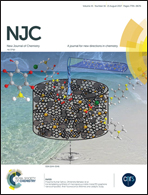A solvatochromic cyanostilbene derivative as an intensity and wavelength-based fluorescent sensor for water in organic solvents†
Abstract
A novel solvatochromic fluorescent cyanostilbene derivative 1 with a D–π–A structure was synthesized. The introduction of an electron-donating methoxy group and an electron-accepting nitro group into the π-conjugated cyanostilbene bridge offered an intense intramolecular charge transfer (ICT) process in molecules and endowed 1 with a prominent solvatochromic emission property. Compared with the moderate changes in its absorption spectra in the different solvents, the emission of 1 was strongly dependent on the solvent polarity and could be tuned from blue to red by changing the solvent from apolar toluene to polar dichloromethane (DCM). Significantly, 1 can function as an efficient intensity and wavelength-based fluorescent sensor for the detection of trace water in THF and dioxane, respectively. A low detection limit of 71 ppm in THF made it a supersensitive water sensor for practical applications. A remarkable red shift of about 45 nm in dioxane made 1 an efficient wavelength-based fluorescent sensor for water avoiding external disturbance, whose emission color can be easily observed and distinguished by the naked eye. Moreover, the easy-to-prepare test papers loaded with 1 provide a simple and low cost protocol for the qualitative and quantitative detection of the water content in organic solvents without resorting to instrumental analysis.



 Please wait while we load your content...
Please wait while we load your content...